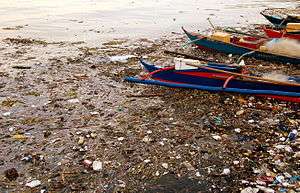Pollution of the Pasig River

The Pasig River in the Philippines suffers from a high level of water pollution and efforts are being made to rehabilitate it.
After World War II, massive population growth, infrastructure construction, and the dispersal of economic activities to Manila's suburbs left the river neglected. The banks of the river attracted informal settlers and the remaining factories dumped their wastes into the river, making it effectively a huge sewer system. Industrialization had already polluted the river.[1]
In the 1930s, observers noticed the increasing pollution of the river, as fish migration from Laguna de Bay diminished. People ceased using the river's water for laundering in the 1960s, and ferry transport declined. By the 1970s, the river started to emanate offensive smells as a result of waste from swine and poultry establishments in the area where protected Marikina watershed is located (Pinugay,Baras,Rizal) and in the 1980s, fishing in the river was prohibited. By the 1990s, the Pasig River was considered biologically dead[1]
Rehabilitation efforts
Efforts to revive the river began in December 1989 with the help of Danish authorities. The Pasig River Rehabilitation Program (PRRP) was established, with the Department of Environment and Natural Resources as the main agency with the coordination of the Danish International Development Assistance (DANIDA).[2]
In 1999, President Joseph Estrada signed Executive Order No. 54 establishing the PRRC to replace the old PRRP with additional expanded powers such as managing of wastes and resettling of squatters.[2]
See also
References
- 1 2 Pasig River Rehabilitation Program
- 1 2 "A dying river comes back to life" - Santelices, Menchit. Philippine Information Agency.